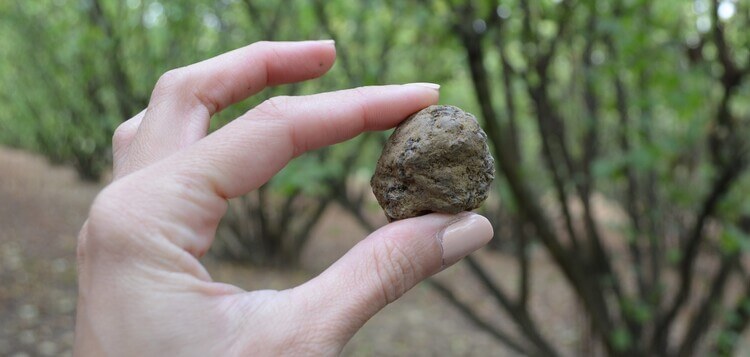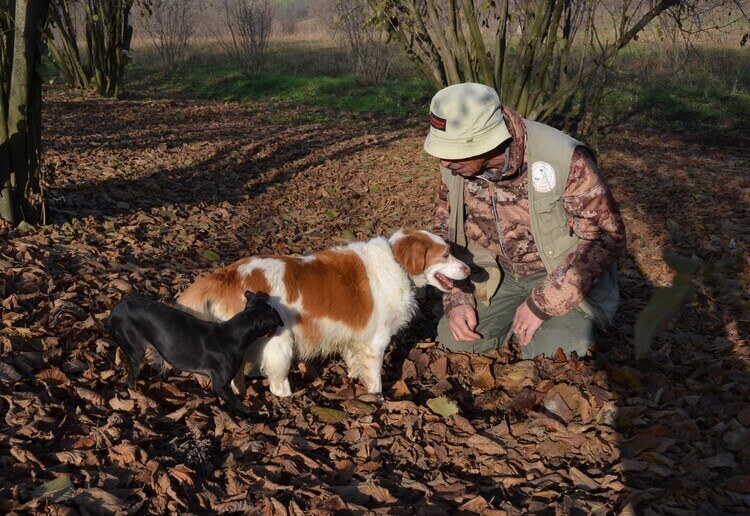Complete Guide to Truffle Hunting in Piedmont
Alba White and Black Truffles. A special Piedmont Tour!
Italy is well known for its delicious truffles. They grow in almost every Italian region. Piedmont is on the very top of the list because here it grows the rarest of all truffles, the Tuber Magnatum or Alba White Truffle. When planning a tour of Piedmont, consider joining a Truffle Hunting Tour with a local guide!
Piedmont hosts the most significative events dedicated to the truffle world. The International fair of the Alba White Truffle takes place here, every year, in the month of October. In the fall, travellers from all over the world tour Piedmont and book very special truffle hunt experiences hoping to find the rare truffle. Piedmont also hosts the Alba White Truffle World Auction. This event takes place inside the castle of Grinzane Cavour, every year in the month of November. The tradition of world auctions started in 1999. Every year, the most prestigious specimens of Tuber magnatum Pico, the best Alba White Truffles, are put up for auction, for charity purposes.
In November 2022, a record-breaking truffle sold for € 184,000 and was shipped to Hong Kong. But that wasn’t the only record. Also the charity fundraising reached a completely new level with its 600,000 €!
Every country follows strict regulations when it comes to truffle hunting. In Italy, each region can customize its rules according to a long lasting truffle hunting tradition. Piedmont is no exeption. Regulations control all aspects of the hunt: the hunting seasons opening and closing, the necessary licenses, the penalties, the areas where the search is allowed, the tools that must be used, the preservation of fresh truffles or related products. There are also specific guidelines as for the truffle dogs training and abilities.
Today the existing kinds of truffles amount to 63, in the entire world. In Italy there are 25 different species of truffle. Only nine of these are edible. And three are considered the most valuable. Every species has its own hunting season depending on the climatic conditions.
Piedmont is one of the few Italian regions where it is allowed to go truffle hunting also at night. The reason can be found in a very long truffle hunting tradition here. In the past, most of the truffle hunters (trifulao in the Piedmont language) were in fact also farmers. That means they used to hunt for truffles at the end of a long day spent in the fields, when the day turned darker, or very early in the morning before sunrise.

Piedmont Truffle Hunting License
National laws regulate truffle hunting in Italy, but each region has specific rules. Who wants to become a truffle hunter must pass a state exam, and collect his permit from the local provincial authority. The truffle hunting license require the payment of an annual tax of about €150.
Piedmont Truffle Hunting:
Where & When
Truffle hunting is allowed in the woods and in the non cultivated areas, with a daily limit of 2 kilograms. This weight limit does not apply if the hunt takes place inside a tartufaia, or truffle ground. There are two kinds of truffle grounds: the controlled ones and the cultivated ones. In the first case, the area is natural truffle ground enhanced with newly planted trees. The second kind is a fertile environment created on purpose, with selected trees whose roots have been treated to facilitate the growth of truffles. The right to hunt on a truffle ground is reserved to the owner. In Piedmont it is forbidden to hunt on lands that have been reforested for a period of time of fifteen years. The truffle hunting seasons in Piedmont are updated every year and the calendar is effective on the entire regional territory. There are only two moments of the year when truffle hunting is strictly forbidden. That is, for about fifteen days, both in the months of May and September. Contact your local guide and book your truffle hunting experience in Piedmont during the best seasons.
Truffles usually start growing a month after an abudant rain. It takes about 4 months for them to reach their maturation. At this point, the truffle hunters have but weeks to find and collect them before they turn into “powder”. Every kind of truffle has a specific harvest season. This time-frame can vary whithin the same region, due to climatic differences. It is very important to observe the regional calendar, and to collect only mature truffles. Doing otherwise might cause the elimination of the so called fioroni. These are truffles with a very low value for the market, but of high importance for the ecosystem. They are infact very rich of spores, and they have proved themselves necessary for the formation of new truffle grounds.
Piedmont is one of the few regions that allows truffle hunting during the night. In the past, truffle hunters used to be also farmers, therefore they had a double life. They would work in the fields during the day, and then, late at night – or very early in the morning – they would go out with their dogs, and walk for miles, looking for truffles.
Truffle Hunting
The tools of the trade
Every truffle hunter needs specific tools to carry on his job. The main ones are a walking stick, a small pickaxe, a piece of cloth and a flashlight. The walking stick is very helpful to both the truffle hunter and his dog. The man uses it to walk on uneven path, but also to point the direction for the dog to follow.
The small pickaxe is used to dig a hole in the ground, in the place indicated by the truffle dog. By using the proper tool, the truffle hunter will do very little damage – if none at all – to the roots of the truffle ground trees. The collected truffles are placed inside the piece of cloth, or directly inside the hunter’s pockets. Lastly, a flashlight is recommended if the hunt takes place in the dark.
One of the reasons why travellers from all over the world visit italy is the possibility to come searching for the Alba White Truffle, in the Langhe - UNESCO World Heritage site of Piedmont
The Truffle Hunter & His Dog
In Piedmont the truffle hunter has many names: tartufaio, in Italian. But also trifulao, or trifulé, in the local dialect. Every truffle hunter has a trained dog at his side. A private truffle hunt tour can introduce you to the beautiful friendship between a man and his passionate helper. Most truffle hunters look for good mixed-breed dogs, especially hunting ones. They have in fact an excellent sense of smell and a natural inclination for the search. But dogs must also be docile, obidient, smart, and have a good resistance to cold weathers.
How to Hunt for Truffles
Experienced truffle hunters mentally map out the local truffle grounds. They always know where to go and when, while looking for truffles. They even cover differents areas during morning and evening hunts.
Once on site, they guide the dog where they believe truffles could be hidden. Most of the hunter’s knowledge in this sense comes from experience. Truffles tend to grow always in the same place. Therefore a good hunter keep tracks of previous findinds. As soon as the dog smells something and start scratching the surface of the ground, the hunter takes over. To prevent the dog from ruining the truffle, the hunter uses his pickaxe to dig a hole all around the truffle. He then carefully collects and cleans it with his hands. Afterwards he places the truffle inside the piece of cloth, and into his pocket. Everytime the dog spots a truffle, the hunter gives him a special treat while he pets him. The dog training clearly requires a lot of time and patience, but it always pays off. The trained truffle dog enjoys the hunt and plays along. After each recovery, the truffle hunter must cover back the hole he escavated. (Truffles can be just a few inches deep in the ground, but they can also reach a one meter depth!). This is one of the final rules for a succesfull truffle hunt.
Book your private truffle hunt with Piedmontours. This is a very special experience that will connect you to the locals and teach you how this very long tradition has been passed on through generations in Northern Italy.
- Spring and Summer Tours of Piedmont - February 26, 2024
- Turin Travel Guide - December 27, 2023
- Wine Tastings in Piedmont - December 15, 2023

